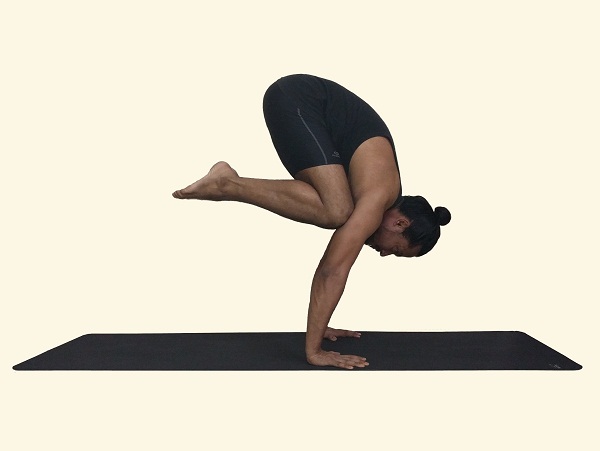Bakasana (‘bak’ means crane) or the crane posture is an arm balancing posture. People often confuse this posture and use it interchangeably with Kakasana (the crow posture) because of how similar both look. In my opinion, this posture is way more difficult than the Crow pose because it requires a lot of wrist, forearms, shoulders, and core strength. The main difference, the Crow pose – has bent arms whereas the Crane pose – has straight arms. We recommend you check out this article to find out more differences between the two postures.
**Read about proper hand placement and alignment for arm balancing postures to keep your wrists safe and injury-free.
This pose can develop a lot of strength required to balance in Hand-stands and train the body for press-handstand. Like any other arm balancing pose, this also requires prior knowledge of proper hand placements and alignment. Another requirement for this pose is hip flexibility. As you can see in the photo below the knee is in the armpit and the thigh is touching the stomach so your hips should be flexible enough to do this. To check the hip flexibility you can try Mal-asana (the deep squat pose). If you are comfortable in Mal-asana then you are probably ready for this pose in terms of flexibility.
Some times you might not be able to do the deep squat pose (mal-asana) because of your inflexible ankles and not because of you hips. To still test you hip flexibility you can put something (a folded mat, etc) under your heels and try the pose. If your thigh is touching the stomach in this modified version then probably you have enough hip flexibility in this direction to execute Crane pose.

Steps for Bakasana (Crane pose)
- Squat on the floor with feet about shoulder-width apart (put a folded mat under your heel if your ankle are not flexible enough- you will know this if you are falling back when you try the deep squat)
- Place the hands flat on the floor in front of the feet with the fingers facing forward. Keep the fingers wide apart.
- Rise on your toes lean forward and place the knee on the upper arm (preferably in the armpit, you might need to continuously train your deep squats- mal-asana to do so).
- Lean forward further transferring the body weight to the arms and lifting the hips up higher and then lifting one foot after the other. Initially, you might need to keep the arms a bit bent but finally, work on straightening the arms as much as you can.
- Bring the feet closer so that the big toes are touching each other. Hold the final position for as long as is comfortable.
- Slowly lower the feet to the floor and relax.
Note: Retain the breath in the final position if holding the pose for a short period or if you have just started it, breath retention might help you to engage your core (uddiyana bandha) a bit better, once you are stable in the pose then start breathing deep while keeping the core engaged. As a precautionary measure keep a pillow or some soft cushion in front of you because there can be a tendency to fall on your face.
Benefits for Bakasana (Crane posture)
- Strengthens the wrists, arms, shoulders, and core (it can prepare the body for press handstands).
- Stretches the upper back and increases the flexibility and elasticity of the spine.
- The sense of balance, concentration, and coordination improve by practicing this posture regularly.
Contraindications:
- Pregnancy
- Neck problems or spondylitis
- Carpal tunnel syndrome
- High blood pressure
- Heart disease
- Cerebral thrombosis
Looking for other arm balancing postures? Check our Arm-balancing library.